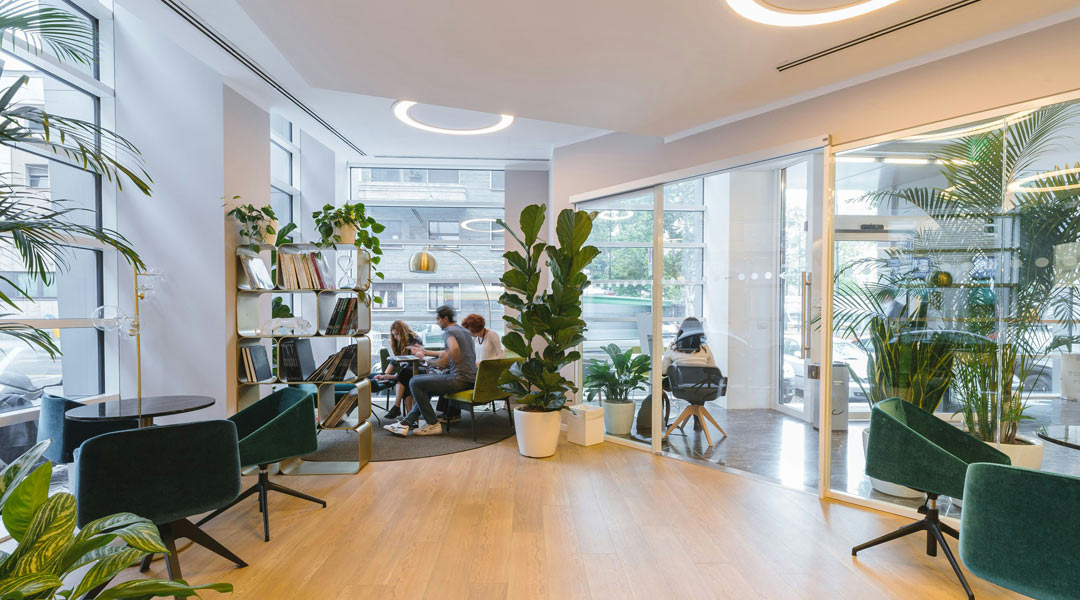Overview of Sustainable Coworking
Sustainable coworking refers to workspaces that prioritize environmental responsibility by adopting practices that reduce ecological impact while fostering collaboration among members. This approach not only addresses environmental concerns but also enhances the appeal of coworking spaces as they cater to the growing demand for eco-conscious business practices.
With approximately 20,000 coworking spaces currently in existence and projections indicating this number could double by 2024, the importance of sustainability in this sector is more pronounced than ever. By focusing on sustainable practices, coworking spaces can significantly enhance their brand reputation, attracting a clientele that values eco-friendliness and social responsibility.

Embracing Technology for Sustainable Coworking
Technology is a key driver of sustainable coworking, helping spaces reduce their environmental footprint while optimizing efficiency.
Many coworking hubs now implement smart systems to track energy consumption and resource usage in real time, allowing for data-driven adjustments that minimize waste.
For instance, energy-efficient technologies can analyze usage patterns, enabling automated climate control and lighting adjustments that significantly lower energy costs.
By integrating these innovations, coworking spaces not only enhance sustainability but also position themselves as forward-thinking pioneers in the evolving world of eco-conscious work environments.

Importance of Sustainable Practices
Implementing sustainable coworking practices offers a range of advantages, from lowering utility costs to enhancing member satisfaction. By integrating eco-friendly initiatives—such as energy-efficient lighting, renewable energy sources, and comprehensive waste reduction programs—coworking spaces can set themselves apart in a competitive market.
This commitment to sustainability not only attracts members who value environmental responsibility but also fosters long-term loyalty, as many are willing to invest in workspaces that align with their ethical and ecological priorities.

The Benefits of Sustainable Coworking
Beyond financial benefits, sustainable coworking has a profound impact on workplace morale, employee retention, and overall well-being. Research indicates that professionals working in environmentally responsible spaces experience higher job satisfaction, improved focus, and a stronger sense of belonging.
A workspace designed with sustainability in mind—featuring natural lighting, indoor plants, and eco-friendly materials—can contribute to reduced stress levels and enhanced productivity, ultimately fostering a more positive work environment.
A stable, engaged workforce is particularly crucial in the ever-evolving coworking industry, where flexibility and collaboration are key drivers of success. Members who feel connected to their workspace and its values are more likely to stay long-term, reducing turnover and strengthening the coworking community. Moreover, businesses and freelancers actively seek out coworking spaces that align with their sustainability goals, making green coworking hubs more attractive to modern professionals.
In addition, adherence to environmental regulations through sustainable initiatives helps mitigate legal risks and potential fines, ensuring long-term business resilience and credibility. As governments and organizations worldwide continue to implement stricter sustainability guidelines, coworking spaces that proactively adopt green practices will not only stay ahead of compliance requirements but also position themselves as leaders in the future of work. By embracing sustainability, coworking spaces can create a more ethical, responsible, and future-proof business model that benefits both their members and the planet.
Sustainable Coworking: Eco-Friendly Practices for a Greener Workspace
Creating a truly sustainable coworking space requires a commitment to eco-friendly practices that reduce environmental impact while enhancing operational efficiency. Implementing energy-efficient systems—such as LED lighting, smart thermostats, and renewable energy sources—is a fundamental step in minimizing energy consumption. For example, transitioning to LED lighting can significantly lower electricity usage, reducing costs and reinforcing a workspace’s commitment to sustainability.
Waste reduction is another key pillar of sustainable coworking. Establishing robust recycling programs and composting stations helps divert waste from landfills while encouraging an environmentally conscious community. Clearly marked recycling and compost bins in communal areas make participation seamless and intuitive for members.

Real-World Success: Case Studies in Sustainable Coworking
Successful examples of sustainable coworking spaces showcase the measurable benefits of eco-friendly initiatives. Bond Collective, for instance, introduced a simple “everything off at night” policy, resulting in annual energy savings of over $3,000. This demonstrates how even small operational changes can lead to substantial cost reductions while instilling sustainable habits among members.
Many green coworking spaces go a step further by integrating renewable energy sources like solar panels and wind turbines, achieving greater self-sufficiency while lowering operational expenses. Additionally, industry leaders such as WeWork have pursued recognized sustainability certifications, reinforcing their commitment to environmentally responsible practices. These certifications not only enhance brand reputation but also attract professionals and businesses that prioritize sustainability.

Sustainable Design and Resource Conservation
Additionally, incorporating sustainable materials in design—such as low-VOC paints, upcycled furniture, and eco-friendly flooring—creates a healthier indoor environment. Water conservation efforts, including low-flow fixtures and energy-efficient appliances, further support sustainability goals, reinforcing the commitment to resource stewardship.
By integrating these eco-friendly initiatives, coworking spaces can cultivate a responsible, future-oriented work environment that aligns with the values of modern professionals while reducing their overall ecological footprint.
Tips for Implementing Green Practices
To effectively implement green practices in coworking spaces, establishing a dedicated sustainable office team is essential. This team can focus on brainstorming and executing eco-friendly initiatives, ensuring a structured and strategic approach to sustainability. Engaging employees through green challenges can also foster a culture of sustainability, motivating members to participate in environmentally friendly practices.

One step at a time
Starting with one sustainable practice and gradually introducing additional initiatives can facilitate a smoother transition. For example, a coworking space might first implement a recycling program before expanding to other areas such as composting or energy-efficient systems. Regular training sessions on sustainability can keep employees informed and motivated about green practices. Providing incentives, like discounts for members who utilize public transportation, can further encourage participation and strengthen the commitment to sustainability within the community.
Building a Community Around Sustainability
Beyond financial and environmental gains, sustainable coworking spaces foster a sense of community by actively involving members in green initiatives. Whether through waste reduction programs, shared sustainability goals, or educational events, these spaces create a work environment where eco-conscious professionals feel inspired and engaged.

Fostering Collaboration Through Sustainability
Sustainable coworking spaces inherently promote a collaborative environment, often hosting networking events and workshops focused on sustainability. These initiatives not only foster community but also provide valuable learning opportunities for members to share ideas and practices related to eco-friendliness. For instance, organizing a monthly workshop on sustainable business practices can enhance member engagement and knowledge-sharing.

Biophilic Design for a Healthier Workspace
Incorporating biophilic design elements, such as indoor plants and natural light, contributes significantly to a sustainable coworking environment.
This design approach not only improves mental health and productivity among members but also promotes a stronger connection to nature.
Community gardens or green spaces within coworking areas can serve as relaxing environments, fostering biodiversity and enhancing the overall workspace atmosphere.
Encouraging members to share ideas and resources on sustainability can further strengthen community bonds and inspire innovation, creating a supportive network focused on eco-conscious practices.
The Future of Sustainable Coworking
The rise of sustainable coworking reflects a broader societal shift toward eco-conscious business practices. Regular monitoring and active community engagement are essential to maintaining and improving sustainable initiatives. By integrating smart technology, coworking spaces can enhance energy efficiency, reduce operational costs, and showcase the powerful synergy between innovation and sustainability.


Growth and Opportunities in Green Coworking
As the demand for sustainable work environments increases, coworking spaces that prioritize eco-friendliness are poised for growth in both membership and revenue.
Achieving green certifications and implementing energy-efficient solutions will further boost their appeal to environmentally conscious businesses and freelancers.
By fostering a culture centered on sustainability, these spaces not only minimize their environmental footprint but also cultivate a thriving community of like-minded professionals dedicated to creating a greener future.


